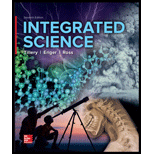
Integrated Science
7th Edition
ISBN: 9780077862602
Author: Tillery, Bill W.
Publisher: Mcgraw-hill,
expand_more
expand_more
format_list_bulleted
Textbook Question
Chapter 19, Problem 1CQ
What is an organic compound?
Expert Solution & Answer
To determine
The meaning of the term “organic compound.”
Answer to Problem 1CQ
An organic compound is a compound that contains carbon as the main element. Living or nonliving systems can synthesize organic compounds.
Explanation of Solution
Carbon is one of the several vital elements, which make all the living things. Carbon has a valency of four which allows it to form four bonds with four atoms. A compound, in which carbon is the main element and is formed by a living or nonliving system, is called an organic compound. The study of carbon-containing compounds is known as organic chemistry. Organic compounds cover a wide range of molecules, for example, plastics, gasoline, and glucose.
Want to see more full solutions like this?
Subscribe now to access step-by-step solutions to millions of textbook problems written by subject matter experts!
Students have asked these similar questions
2
3
Imagine you are out for a stroll on a sunny day when you encounter a lake. Unpolarized light from the sun is reflected off the lake into your eyes. However, you notice when you put on your vertically polarized sunglasses, the light reflected off the lake no longer reaches your eyes. What is the angle between the unpolarized light and the surface of the water, in degrees, measured from the horizontal? You may assume the index of refraction of air is nair=1 and the index of refraction of water is nwater=1.33 . Round your answer to three significant figures. Just enter the number, nothing else.
Chapter 19 Solutions
Integrated Science
Ch. 19.1 - Prob. 1SCCh. 19.1 - Prob. 2SCCh. 19.2 - Prob. 3SCCh. 19.2 - Prob. 4SCCh. 19.2 - Prob. 5SCCh. 19.3 - Prob. 6SCCh. 19.3 - Prob. 7SCCh. 19.4 - Prob. 8SCCh. 19.4 - Prob. 9SCCh. 19.5 - Prob. 10SC
Ch. 19.6 - Prob. 11SCCh. 19.6 - Prob. 12SCCh. 19.6 - Prob. 13SCCh. 19.6 - Prob. 14SCCh. 19.6 - What is the job of a chaperone protein? a....Ch. 19 - What is an organic compound?Ch. 19 - Prob. 2CQCh. 19 - Prob. 3CQCh. 19 - Prob. 4CQCh. 19 - Prob. 5CQCh. 19 - Prob. 6CQCh. 19 - Prob. 7CQCh. 19 - Prob. 8CQCh. 19 - Prob. 9CQCh. 19 - Prob. 10CQCh. 19 - Prob. 11CQCh. 19 - Prob. 12CQCh. 19 - Prob. 13CQCh. 19 - Prob. 14CQCh. 19 - Prob. 15CQCh. 19 - Prob. 16CQCh. 19 - Prob. 17CQCh. 19 - Prob. 18CQCh. 19 - Prob. 19CQCh. 19 - Prob. 1PEACh. 19 - Prob. 2PEACh. 19 - Prob. 3PEACh. 19 - Prob. 1PEBCh. 19 - Prob. 2PEBCh. 19 - Prob. 3PEB
Knowledge Booster
Learn more about
Need a deep-dive on the concept behind this application? Look no further. Learn more about this topic, physics and related others by exploring similar questions and additional content below.Similar questions
- 20. Two small conducting spheres are placed on top of insulating pads. The 3.7 × 10-10 C sphere is fixed whie the 3.0 × 107 C sphere, initially at rest, is free to move. The mass of each sphere is 0.09 kg. If the spheres are initially 0.10 m apart, how fast will the sphere be moving when they are 1.5 m apart?arrow_forwardpls help on allarrow_forwardpls help on thesearrow_forward
- pls help on all asked questions kindlyarrow_forwardpls help on all asked questions kindlyarrow_forward19. Mount Everest, Earth's highest mountain above sea level, has a peak of 8849 m above sea level. Assume that sea level defines the height of Earth's surface. (re = 6.38 × 106 m, ME = 5.98 × 1024 kg, G = 6.67 × 10 -11 Nm²/kg²) a. Calculate the strength of Earth's gravitational field at a point at the peak of Mount Everest. b. What is the ratio of the strength of Earth's gravitational field at a point 644416m below the surface of the Earth to a point at the top of Mount Everest? C. A tourist watching the sunrise on top of Mount Everest observes a satellite orbiting Earth at an altitude 3580 km above his position. Determine the speed of the satellite.arrow_forward
- pls help on allarrow_forwardpls help on allarrow_forward6. As the distance between two charges decreases, the magnitude of the electric potential energy of the two-charge system: a) Always increases b) Always decreases c) Increases if the charges have the same sign, decreases if they have the opposite signs d) Increases if the charges have the opposite sign, decreases if they have the same sign 7. To analyze the motion of an elastic collision between two charged particles we use conservation of & a) Energy, Velocity b) Momentum, Force c) Mass, Momentum d) Energy, Momentum e) Kinetic Energy, Potential Energyarrow_forward
arrow_back_ios
SEE MORE QUESTIONS
arrow_forward_ios
Recommended textbooks for you
 An Introduction to Physical SciencePhysicsISBN:9781305079137Author:James Shipman, Jerry D. Wilson, Charles A. Higgins, Omar TorresPublisher:Cengage Learning
An Introduction to Physical SciencePhysicsISBN:9781305079137Author:James Shipman, Jerry D. Wilson, Charles A. Higgins, Omar TorresPublisher:Cengage Learning

 Stars and Galaxies (MindTap Course List)PhysicsISBN:9781337399944Author:Michael A. SeedsPublisher:Cengage Learning
Stars and Galaxies (MindTap Course List)PhysicsISBN:9781337399944Author:Michael A. SeedsPublisher:Cengage Learning

An Introduction to Physical Science
Physics
ISBN:9781305079137
Author:James Shipman, Jerry D. Wilson, Charles A. Higgins, Omar Torres
Publisher:Cengage Learning




Stars and Galaxies (MindTap Course List)
Physics
ISBN:9781337399944
Author:Michael A. Seeds
Publisher:Cengage Learning
The Laws of Thermodynamics, Entropy, and Gibbs Free Energy; Author: Professor Dave Explains;https://www.youtube.com/watch?v=8N1BxHgsoOw;License: Standard YouTube License, CC-BY